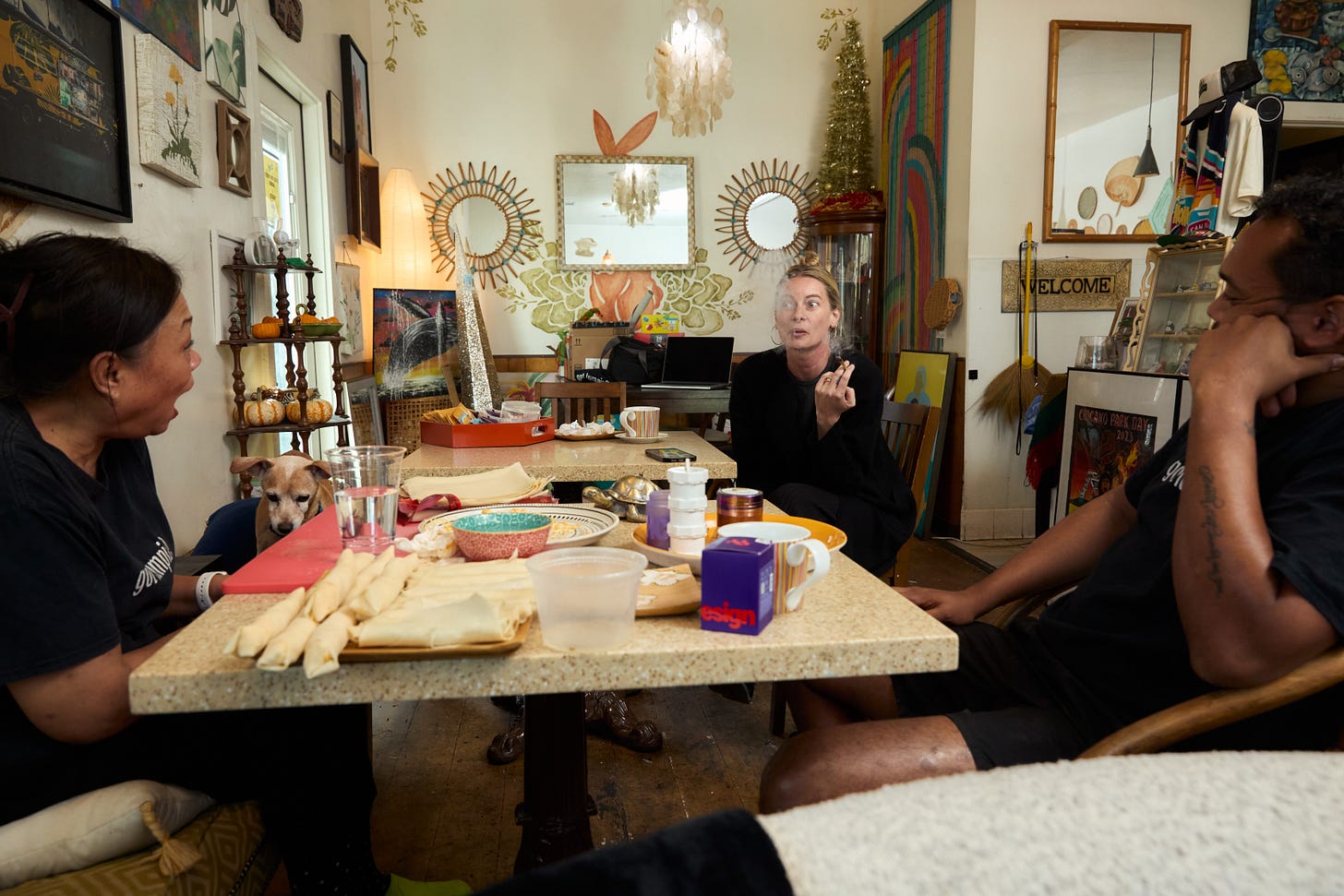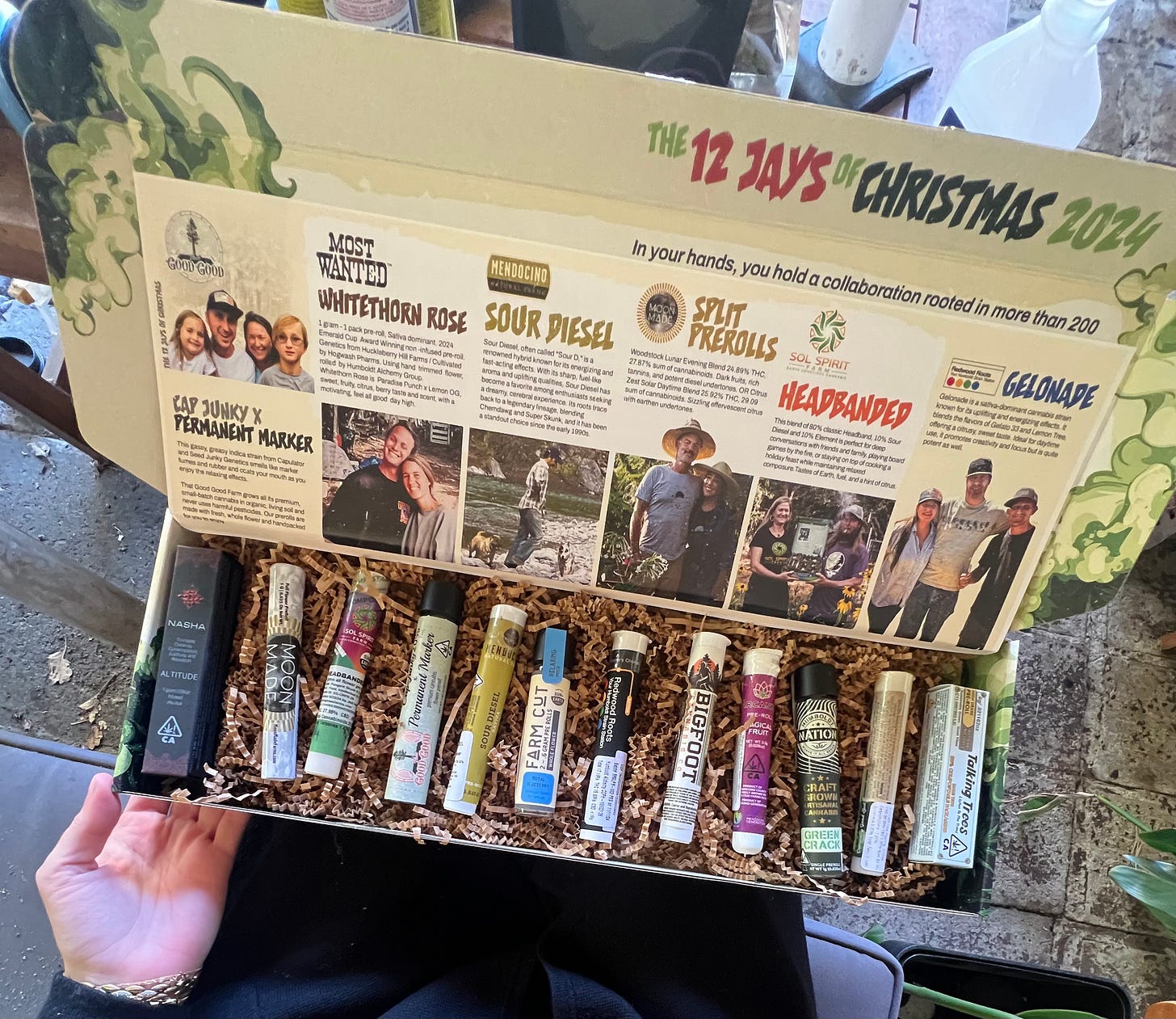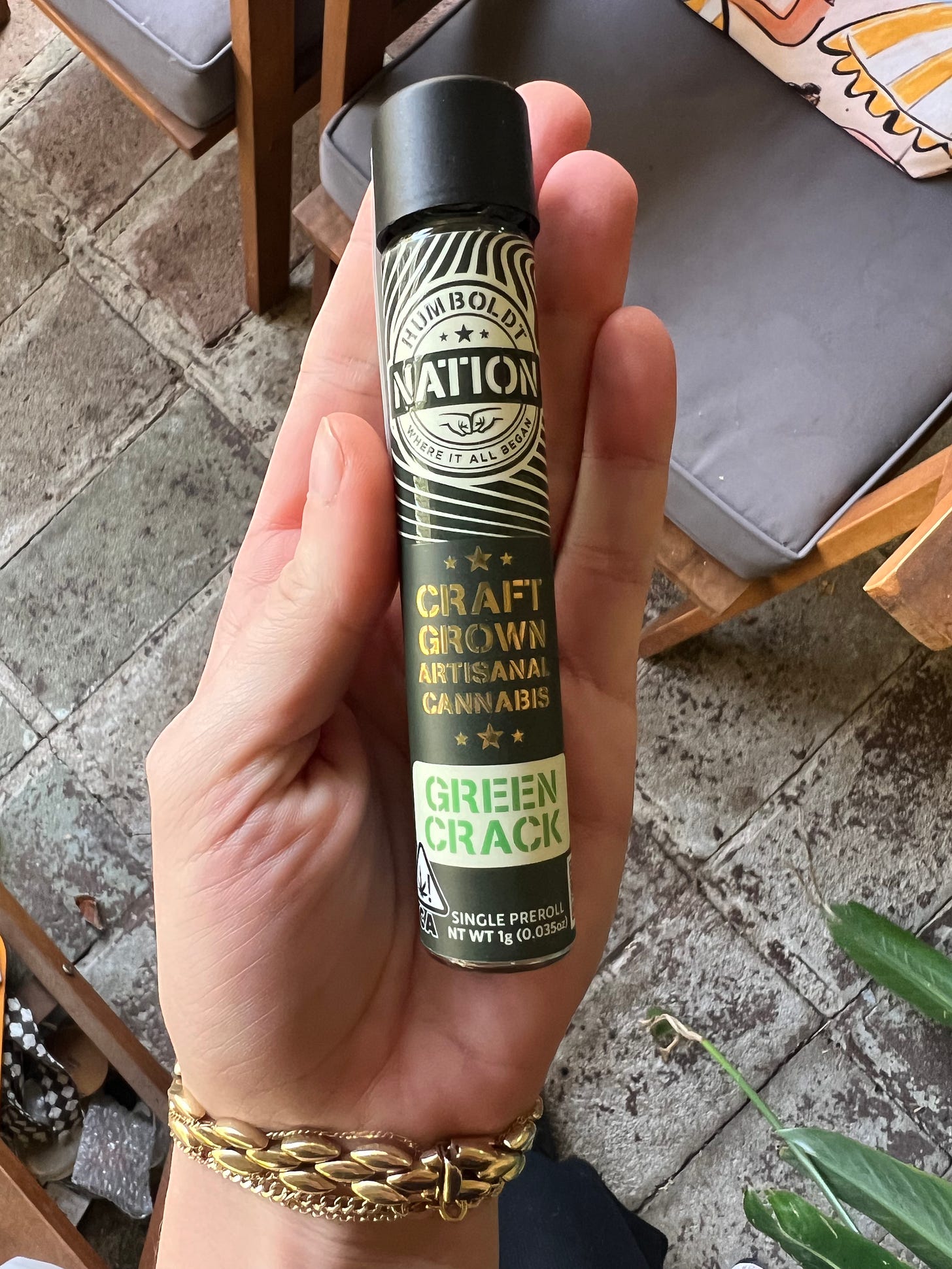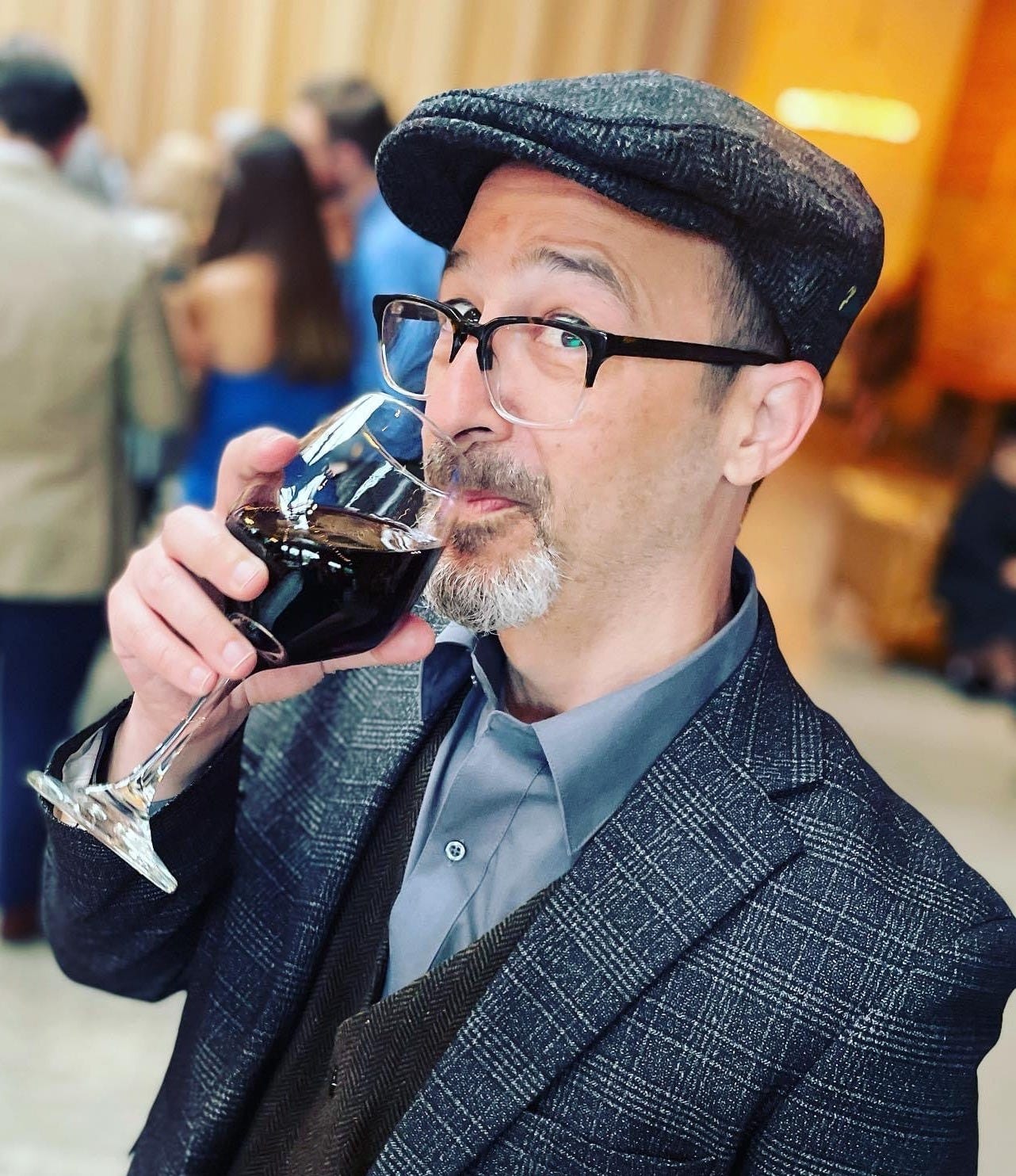Overthinking and yapping: What stoners do best
Reflections on surviving another year in media, weed and creativity, and a special Emerald Triangle collab

I’m writing from my first vacation in over two years that isn’t medical or childcare-related! I have no plans other than kicking out a newsletter–at least one—and enjoying the SoCal winter weather as our tourists do.
I get as reflective as everyone else does at the end of the year, probably also because my birthday is the Winter Solstice. And also because I am a huge pothead, the kind in the rotation who holds the joint until I’m finished telling my story (I am sorry).
As everyone else begins a new year, so do I, as far as bodily rotations around the sun are concerned. As they have been, this year was not easy at all, but I haven’t ever been able to say a year has been outright bad or good because that’s just not how life works. Not even the year when I got divorced from my ex-husband while relying on a full-time freelance journalism income, not the year when I had a baby, and my actual, current husband was laid off six weeks later, sending my ass back to work after my leave in need of a more highly monetized career path, since we are both journalists. We live in the decline of media jobs and monetization and can no longer play sacrificial lamb to our editorial egos. That’s partly how I ended up on the business side of San Diego Magazine this year, ideating and selling our agency media work, which, long-term is likely to pay more than editorial work. He pivoted to journalism academia.
I haven’t been able to properly mourn stepping out of traditional journalism production as my day job to create and sell branded media, probably because I actually really like my new gig, and also, I’m a working mom. Time is limited. I remind myself that I still have Cannabitch, I’m a co-host of two podcasts (one food- and one weed-related guest spot), I still have my book proposal and my agent, I still have whatever it is I put on various social media platforms. I have become a cannabis news talking head. I didn’t expect that last career pivot—at least not so soon in the historical timeline of legal cannabis—but it’s come for me in the form of emceeing, guest hosting, and commenting in newscasts and articles. It keeps me visible in the cannabis universe and requires me to stay updated on current events, so I’m grateful.
I have no idea what’s in store for 2025, honestly. I am in the fire hose phase of life, which I have chosen to accept. Keeping Cannabitch alive, after my day job and my family, is always at the top of the list. I’ll teach a social media and reporting class at San Diego State University next semester. I’ve got a cannabis feature printing in the February issue of SDM, the potential to publish more regular cannabis journalism at SDM, and a lot of video work coming down the pike. Like, I’m helping to produce a few big video series right now. I bought a video camera this year. I sold sponsorships, brought on clients. I can write voiceover scripts, coach on-camera subjects, and edit video. I couldn’t say that a year ago. So things are good, if different.
As someone who has always been entrepreneurial and ambitious and has felt I have had a lot to prove, I’m overwhelmed by what I see as opportunity in media’s ashes. There are many lanes to take, strategies to try, and platforms to become familiar with. I don’t have time to test everything, especially in the self-publishing realm, but I’m intrigued and I’m here, and I guess next year will be yet another exercise in intuitively throwing shit at the wall to see what sticks. Part of that process means making peace with what inevitably takes a back seat so that other things can shine—in 2024, video replaced writing for me, which feels a bit like I lost a limb, but I can also feel the stub of a new one taking shape. I’m trying not to judge it. Maybe I will become a video documentarian. I ask myself, “Remember when you were a completely unpublished writer?” Crazier things have happened.
Stop me if you’ve heard this before, but this is an “incredibly pivotal time in the history of cannabis.” For Cannabitch, I intend to continue watching, taking notes, and dissecting legalization as the process continues. Specifically, I am interested in how rescheduling will affect consumption habits and access and how that will change the culture again. Expect more videos, guest writers, and cultural dissection, which includes business and politics. This space is different than others in cannabis: it will never be one of those news digests that will keep you minute-by-minute informed on the breakneck cannabis news cycle, nor is it one that strives to capture something hot on the news cycle unless it also sparks my interest. At this stage in Cannabitch, it’s clear that everyone here is so because they seem to value my take on things and what and who I choose to bring to your attention. That’s always what I’ve been best at, much as I also love reporting, and it’s what has made me a good culture writer, editor, and media strategist. So that’s what I’ll continue to do.
I will also most definitely be smoking cannabis, of course, and will share with you as I always do what I come across. Thank you for sticking with me all these years—it will be five years for the newsletter this May. Eight since the column began! Since cannabis years are like dog years, that is now 56 years. Incredible.
A Christmas Present That Does Not Actually Have Anything to Do with Christmas; Makes Great Anthropological Gift Year-Round
Okay, this is not the best example of the quality video work I’ve been producing, but it does show genuine stoke, and I made it entirely on the fly and on my phone. Dina Nagib of Grass Goddess Consulting, who also lives in San Diego, snagged a couple of the highly coveted 12 Jays of Christmas boxes to distribute down here in No Man’s Land, where the legal cannabis distribution networks seem to reach us much less than they do other parts of California. I’d seen videos of the box circulating on social media and figured it was one thing I’d have to live without until Dina texted me on my birthday last week to ask if she could drop one off.
This box contains a small snippet of the life’s work of some of my favorite small family farms from the Emerald Triangle: Emerald Spirit Botanicals in Mendocino, who are known for unique cultivars expressing non-THC cannabinoids and rarer terpenes; Moon Made Farms from Southern Humboldt, helmed by the great Tina Gordon; Arcanna Flowers, which is another Mendo farm that’s part of the Mendocino Generations cohort, and run by growers who ask you to text them the effects after smoking so they can dial in their pheno hunts; and That Good Good Farm, which is not a farm I was familiar with before the box. It’s an off-grid, solar-powered, living-soil-based family farm in the Anderson Valley that hand-trims its flower, and its contribution to the box is a Cap Junky x Permanent marker doink that is gassy, rubbery, and oily in all the right ways. It’s fucking beautiful. These are pre-rolls worth buying. I am now desperate to get my hands on some of the farm’s “True OG.”
Also in the box: Headbanded from Trinity County’s Sol Spirit Farm (where you can book a real, actual cannabis farm glamping vacation!), which blends 80% of one of my all-time favorite smokers with Sour Diesel and Element; a white labeled Whitethorn Rose, which has become one of the patron strains of Humboldt County, I think (It’s been fun to see the Huckleberry Hill Farms-created cultivar pop up more in hash, too); beautiful Sour D’s and Green Crack.
Rarely are pre-rolls worth it, but this collection boasts twelve made with more whole flower than not, unique cultivars not often seen in indoor industrial cannabis, and a lot of heart from deep Northern California, a historic cannabis-producing region struggling mightily under legalization. If you aren’t able to regularly sample these growers’ wares, this is a good way to try. It’s apparently available at dispensaries across LA and Northern California. I am told you could reach out to anyone involved on socials to finagle some kind of exchange maybe. Who am I to say? That’s just what I heard. Happy hunting!
Blazing Trails: How Cannabis Ignites the Creative Spark
So often, we are bombarded with the trope of the lazy stoner. It’s a culture war classic, and if the bloviation at the top of this letter is any proof, it is a label with which I do not identify. It’s also one weed enthusiasts play into: The Dude in The Big Lebowski. Kelso from That ’70s Show. Thurgood Jenkins in Half Baked. Jay and Silent Bob, the entire movie How High. Even Shaggy in Scooby-Doo! Lovable foils whom we all support despite their apparent flaws, all of which seem to be related to cannabis. Wait, what!? Do you see what I mean?
Earlier this year, fellow San Diego writer, podcaster, and all-around media person with a naturally apropos name, Adam Greenfield, asked me to be a guest on his podcast, The Written Scene. We smoked and talked about process and creativity, and you can hear us grappling with changing media in real time. He wanted to know if weed was part of my creative toolkit—as someone with diagnosed ADHD, I actually believe that, yes, cannabis does help me harness creative thoughts, which is anecdotal and subjective.
There have been studies done on this exact topic: the NIH says, as a result of this study, that cannabis with low potency does not have any impact on creativity, while highly potent cannabis impairs divergent thinking. The study quotes Steve Jobs, who once said, “The best way I could describe the effect of the marijuana and hashish is that it would make me relaxed and creative.” I believe significant THC impairment would quash divergent thinking, seeing as I am neurodivergent and use it for that purpose. I also think the key to why people feel more creative after using cannabis might be in that “relaxed” state Jobs found himself, which may mean that an absence of stress allows creative thought to flow.
I asked Adam if he would share his experience with weed and creativity here. As the NIH study claimed, “The concept of creativity is not very well defined, and there is no agreement on one particular measure how to assess it.”

By Adam Greenfield
I can still remember when I wrote my first short story. I was eleven years old. The story, Katrina’s Surprise, was a murder mystery involving a detective, an attractive but mysterious client, and a Rolodex. Yes, a Rolodex. That’s how long ago this was.
The story is expectedly atrocious: poor character development, terrible pacing, and cliche descriptions. But it was my first story, and I distinctly remember the feeling throughout the entire writing process: bliss. I created a world of people and places, all the problems the people had, and the solutions to those problems, all out of thin air. It was the first time I realized how much joy storytelling added to my life, which, at the time, was falling apart around me.
I still have the story. It’s how I know it’s so bad.
Four years after penning Katrina’s Surprise, on a warm, humid Maryland autumn night, I took my first puff of weed, probably after removing the significant amount of seeds and stems weed had back then. By this time, I had already dipped my toes in the murky pool of poetry and was finding comfort and relief in its therapeutic nature. With poetry, I could express myself; with stories, I could have fun.
I couldn’t tell you if I went home and wrote after smoking weed. Again, this was way back in the Rolodex days. And besides, I’m not even sure I can tell you what I had for dinner last week. Surely I did write while high, but I don’t remember the act of writing. What I can tell you is I became a much more prolific writer after I became a weed smoker.
In 2015, I published a book of poetry, Regarding the Monkey, through a small press here in San Diego called Puna Press, run by author and artist Ted Washington. During that process, I went through over twenty years of poetry to find candidates for potential print, and I had plenty of publications that I wanted to publish. Some of what I handed over to my editor, Kara Goldfarb, came from a three-year stage of life when I worked overnights at a gas station and wrote poetry on the blank insides of empty cigarette cartons. I still have those, too.
I had consumed a lot of marijuana leading up to that day with my publisher and editor. For nearly 20 years, I was an almost daily smoker with patches of sobriety mixed in for a tolerance reset or known drug tests for jobs.
My writing habit was also a daily endeavor. I was proud of some of it, but I hoped the rest would never see the light of day. But I’d often wonder during those writing and editing sessions if I thought it was good or bad because I was high or if it was actually good or bad. Of the many Grateful Dead shows I’ve been to since the early ‘90s, one of my favorites was when I was sober. Also, out of the many Grateful Dead shows I’ve been to since the early ‘90s, one of my favorites was when I was pretty high.
I’d eventually come to realize in my early 40s that it’s not about weed making me a better or worse writer. It’s about what weed does for my artistic process, and it’s a lot.
My favorite strain is Green Crack. Really, I love any good sativa. I won’t get into the science of it all, but every effect this particular strain is listed to have- focus, happiness, and creativity- is shockingly evident when I smoke it. And while the happiness result is always welcomed, the focus and creative effects have more of an impact on both my writing and my day overall.
I am currently involved in numerous creative projects, both paid and volunteer. It’s rewarding and fulfilling, yet it’s also not great for someone who is easily distracted by hummingbirds outside my window or if the grapes in the fridge are still good or, oh, I don’t know, how the hell I’m going to afford next year’s rent increase. Each morning, I wake up, and it’s like my brain has been trying to figure things out for the last hour, and the rest of me has just arrived at the party. I spend the next hour doing my morning routine, all while my mind is playing handball with thoughts against the inside of my skull.
But then, with a few tokes of whatever sativa I may have on hand, my brain zips into focus, and the thoughts bouncing around come to rest in what I’d describe as a police lineup. Each one says their line, and I know who the first task victim is.
The same thing happens with my writing. Perhaps the plot has turned into the Pandora music app and wandered off, or maybe a line in a poem that will unlock the rest just isn’t coming. Countless times, I have reached for my one-hitter, packed it with enough to get my thoughts in order, and within ten minutes, the attention scope has narrowed its focus, and I’m back in the swing of things.
The creative aspect of this strain and most other sativas of this strength is another valuable tool for my writing. I have often used it when brainstorming story ideas, outlines, or characters. Sometimes, I’m just looking for a particular word for a poem. A few hits, and it’s like a window opens and reveals what I need.
I think it’s also important to point out that this doesn’t always work, nor do I rely on it. At least not as much as when I was younger. I’m also keenly aware of not getting disappointed when whatever writing magic I hoped would happen after smoking doesn’t happen. In the grand scheme of creative things, I still believe that art happens when it happens. Yes, there are ways to nudge things, but as artsy-fartsy as it sounds, it really is true.
So the question is, does weed make me a better writer? That depends on when you asked me in my life. To be clear, though, the answer I had from my teens and into my early 40’s— an emphatic yes— was very wrong. Weed allowed me to write more, making me a better writer.
Adam Greenfield, who also drinks wine, is a San Diego-based author and poet, a regional editor for the San Diego Poetry Annual, and a podcast producer. His book of poetry, Regarding the Monkey, was published in 2015 through Puna Press, and his podcast, The Written Scene, discusses the path and craft of writing with writers and artists of all kinds.
Listen to my episode of The Written Scene here.











